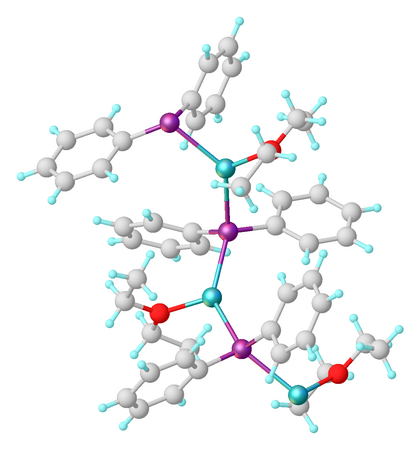
| |
| Names | |
|---|---|
| Preferred IUPAC name Lithium diphenylphosphanide | |
| Identifiers | |
| CAS Number | |
| 3D model (JSmol) | |
| ChemSpider | |
| PubChem CID | |
| CompTox Dashboard (EPA) | |
InChI
| |
SMILES
| |
| Properties | |
| Chemical formula | C12H10LiP |
| Molar mass | 192.13 g·mol |
| Appearance | pale yellow solid |
| Solubility in water | Reacts with water |
| Solubility | Ethers, hydrocarbons |
| Hazards | |
| GHS labelling: | |
| Pictograms |   
|
| Signal word | Danger |
| Hazard statements | H302, H312, H314, H332, H410 |
| Precautionary statements | P260, P261, P264, P270, P271, P273, P280, P301+P312, P301+P330+P331, P302+P352, P303+P361+P353, P304+P312, P304+P340, P305+P351+P338, P310, P312, P321, P322, P330, P363, P391, P405, P501 |
| Except where otherwise noted, data are given for materials in their standard state (at 25 °C , 100 kPa). Infobox references | |
Lithium diphenylphosphide contains lithium and the organophosphorus anion with the formula (C6H5)2PLi. It is a red, air-sensitive solid that is used in the preparation of diphenylphosphino compounds.
Synthesis and reactions
The lithium, sodium, and potassium salts are prepared by reduction of chlorodiphenylphosphine, triphenylphosphine, or tetraphenyldiphosphine with alkali metals (M):
- (C6H5)2PCl + 2 M → (C6H5)2PM + MCl
- (C6H5)3P + 2 M → (C6H5)2PM + MC6H5
- (C6H5)4P2 + 2 M → 2 (C6H5)2PM
They can also be obtained by deprotonation of diphenylphosphine.
With water, the salts convert to diphenylphosphine:
- (C6H5)2PLi + H2O → (C6H5)2PH + LiOH
With halocarbons, the salts react to give tertiary phosphines:
- (C6H5)2PM + RX → (C6H5)2PR + MX
When treated with metal halides, lithium diphenylphosphide gives transition metal phosphido complexes.
Structure and physical properties
Although treated as salts, alkali diphenylphosphides are highly aggregated in solution. They adopt polymeric structures as solids.
As an ether complex, the lithium salt is dark red.
Related compounds
- Sodium diphenylphosphide (CAS RN 4376-01-6)
- Potassium diphenylphosphide (CAS RN 15475-27-1)
References
- Goldsberry, R.; Cohn, Kim; Hawthorne, M. F.; Dunks, G. B.; Wilson, R. J. (1972). "Diphenyl(trimethylsilyl)phosphine and Dimethyl(trimethylsilyl)‐phosphine". In Cotton, F. A. (ed.). Inorganic Syntheses. Vol. 13. pp. 26–32. doi:10.1002/9780470132449.ch7. ISBN 9780470132449.
- Luther, George W. III; Beyerle, Gordon; Cox, Daniel; Cohn, Kim (1977). "Lithium Diphenylphosphide and Diphenyl(Trimethylsilyl)Phosphine". In MacDiarmid, Alan G. (ed.). Inorganic Syntheses. Vol. 17. pp. 186–188. doi:10.1002/9780470132487.ch51. ISBN 9780470132487.
- ^ Bianco, V. D.; Doronzo, S.; Chan, J.; Bennett, M. A. (1976). "Diphenylphosphine". In Basolo, Fred (ed.). Inorganic Syntheses. Vol. 16. pp. 161–188. doi:10.1002/9780470132470.ch43. ISBN 9780470132470.
- Levason, W.; Mcauliffe, C. A.; Barth, R. C.; Grim, S. O. (1976). "Cis‐2‐Diphenylarsinovinyldiphenylphosphine and 2‐Diphenylarsinoethyldiphenylphosphine". In Basolo, Fred (ed.). Inorganic Syntheses. Vol. 16. pp. 188–192. doi:10.1002/9780470132470.ch50. ISBN 9780470132470.
- Bartlett, Ruth A.; Olmstead, Marilyn M.; Power, Philip P. (1986). "Structural Characterization of the Solvate Complexes of the Lithium Diorganophosphides , , and ". Inorg. Chem. 25: 1243–1247. doi:10.1021/ic00228a034.
- Hegedüs, Kristof (12 Dec 2012). "The reaction of triphenylphosphine with lithium..." Pictures from an Organic Chemistry Laboratory. Tumblr. Archived from the original on 12 November 2020. Retrieved 6 January 2025.
{{cite web}}: CS1 maint: multiple names: authors list (link)
